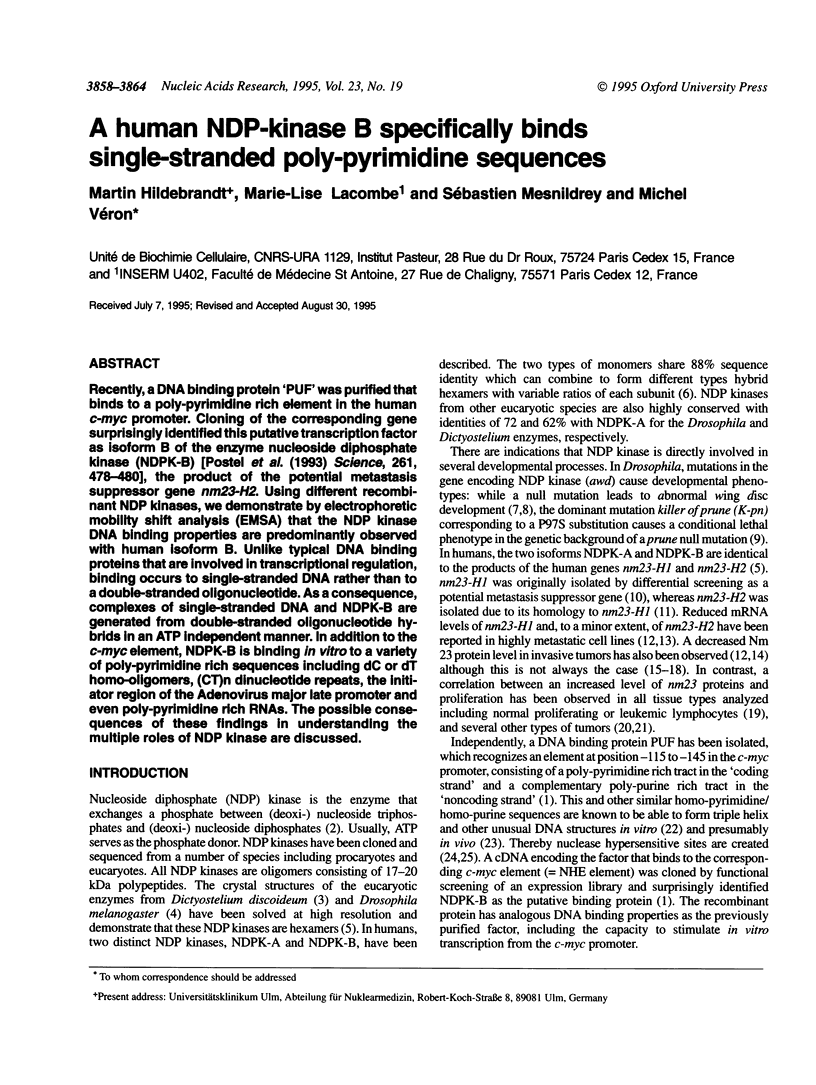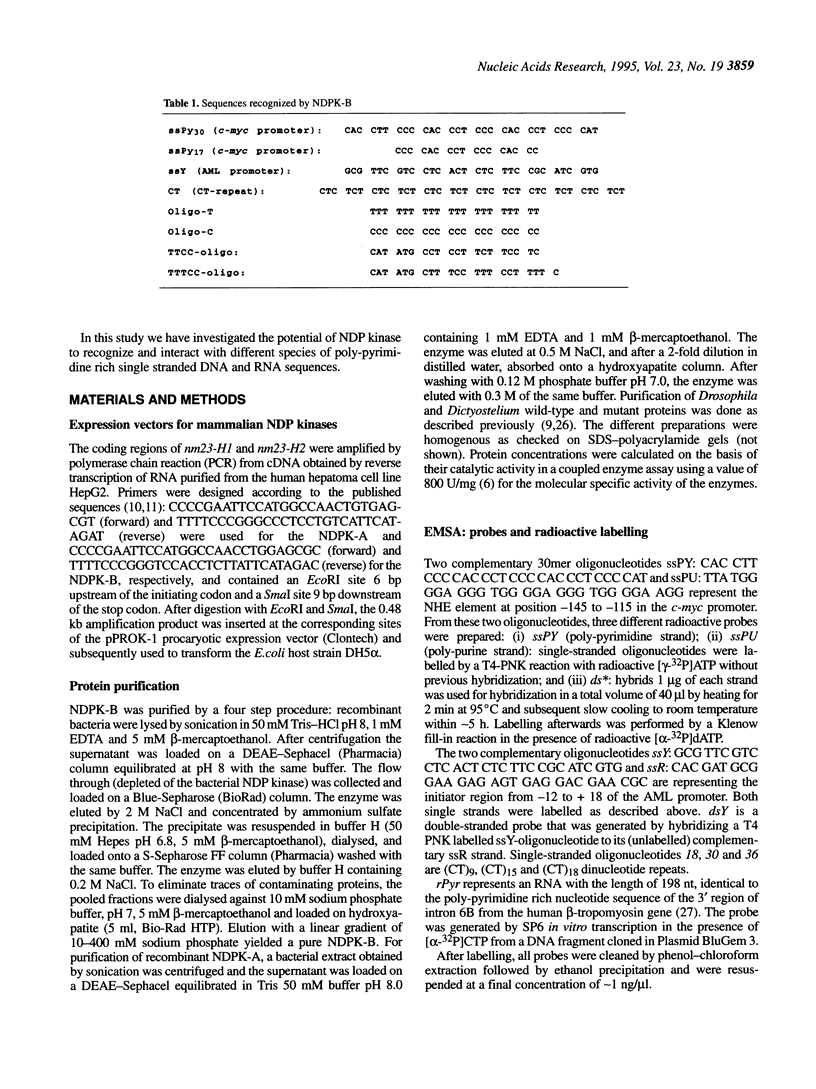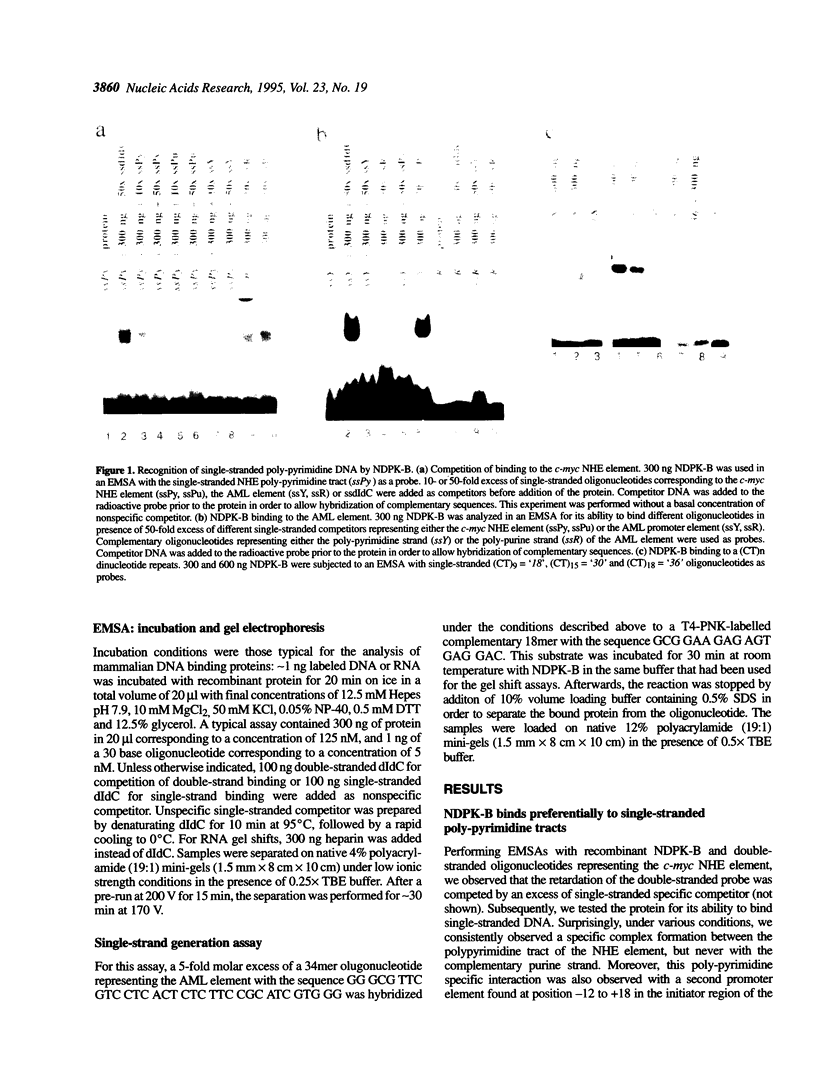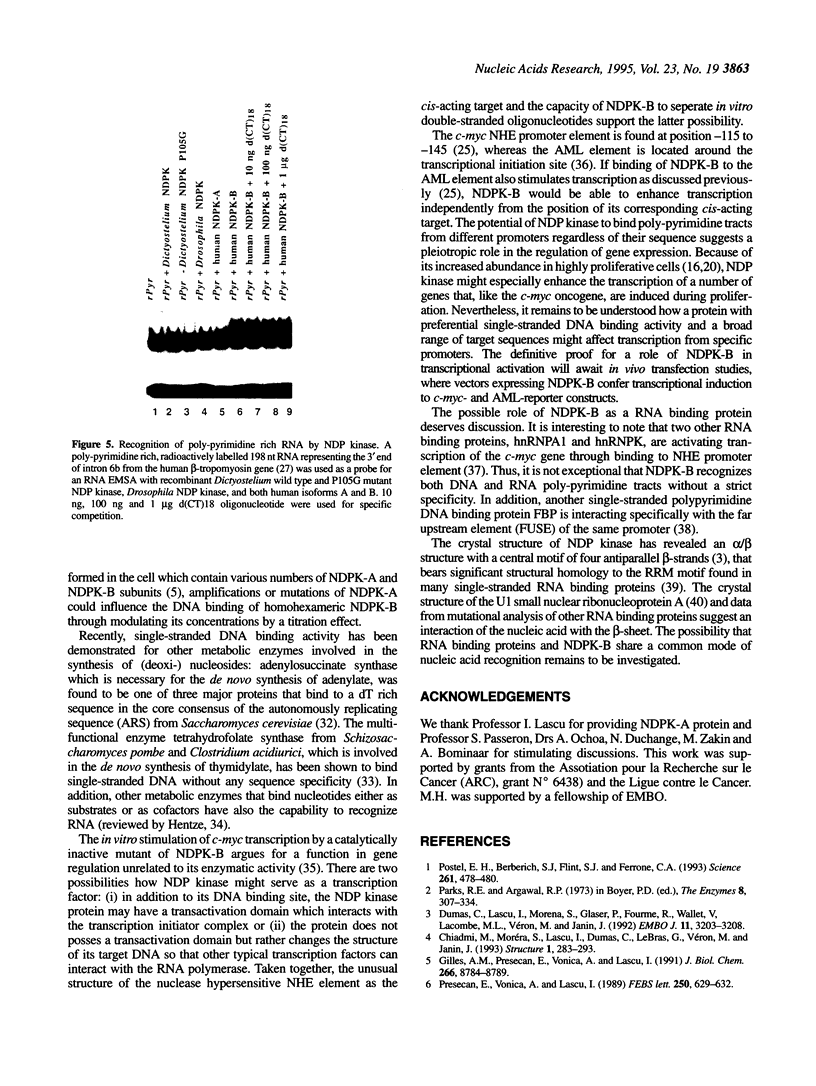Abstract
Recently, a DNA binding protein 'PUF' was purified that binds to a poly-pyrimidine rich element in the human c-myc promoter. Cloning of the corresponding gene surprisingly identified this putative transcription factor as isoform B of the enzyme nucleoside diphosphate kinase (NDPK-B) [Postel et al. (1993) Science, 261, 478-480], the product of the potential metastasis suppressor gene nm23-H2. Using different recombinant NDP kinases, we demonstrate by electrophoretic mobility shift analysis (EMSA) that the NDP kinase DNA binding properties are predominantly observed with human isoform B. Unlike typical DNA binding proteins that are involved in transcriptional regulation, binding occurs to single-stranded DNA rather than to a double-stranded oligonucleotide. As a consequence, complexes of single-stranded DNA and NDPK-B are generated from double-stranded oligonucleotide hybrids in an ATP independent manner. In addition to the c-myc element, NDPK-B is binding in vitro to a variety of poly-pyrimidine rich sequences including dC or dT homo-oligomers, (CT)n dinucleotide repeats, the initiator region of the Adenovirus major late promoter and even poly-pyrimidine rich RNAs. The possible consequences of these findings in understanding the multiple roles of NDP kinase are discussed.
Full text
PDF






Images in this article
Selected References
These references are in PubMed. This may not be the complete list of references from this article.
- Aryee D. N., Ströbel T., Kos K., Salzer-Kuntschik M., Zoubek A., Veron M., Ambros I. M., Traincart F., Gadner H., Kovar H. High nm23-H1/NDPK-A expression in Ewing tumors: paradoxical immunohistochemical reactivity and lack of prognostic significance. Int J Cancer. 1995 Apr 21;64(2):104–111. doi: 10.1002/ijc.2910640206. [DOI] [PubMed] [Google Scholar]
- Barnes R., Masood S., Barker E., Rosengard A. M., Coggin D. L., Crowell T., King C. R., Porter-Jordan K., Wargotz E. S., Liotta L. A. Low nm23 protein expression in infiltrating ductal breast carcinomas correlates with reduced patient survival. Am J Pathol. 1991 Aug;139(2):245–250. [PMC free article] [PubMed] [Google Scholar]
- Biggs J., Hersperger E., Steeg P. S., Liotta L. A., Shearn A. A Drosophila gene that is homologous to a mammalian gene associated with tumor metastasis codes for a nucleoside diphosphate kinase. Cell. 1990 Nov 30;63(5):933–940. doi: 10.1016/0092-8674(90)90496-2. [DOI] [PubMed] [Google Scholar]
- Birney E., Kumar S., Krainer A. R. Analysis of the RNA-recognition motif and RS and RGG domains: conservation in metazoan pre-mRNA splicing factors. Nucleic Acids Res. 1993 Dec 25;21(25):5803–5816. doi: 10.1093/nar/21.25.5803. [DOI] [PMC free article] [PubMed] [Google Scholar]
- Brunel F., Alzari P. M., Ferrara P., Zakin M. M. Cloning and sequencing of PYBP, a pyrimidine-rich specific single strand DNA-binding protein. Nucleic Acids Res. 1991 Oct 11;19(19):5237–5245. doi: 10.1093/nar/19.19.5237. [DOI] [PMC free article] [PubMed] [Google Scholar]
- Chiadmi M., Moréra S., Lascu I., Dumas C., Le Bras G., Véron M., Janin J. Crystal structure of the Awd nucleotide diphosphate kinase from Drosophila. Structure. 1993 Dec 15;1(4):283–293. doi: 10.1016/0969-2126(93)90016-a. [DOI] [PubMed] [Google Scholar]
- Clouet d'Orval B., d'Aubenton Carafa Y., Sirand-Pugnet P., Gallego M., Brody E., Marie J. RNA secondary structure repression of a muscle-specific exon in HeLa cell nuclear extracts. Science. 1991 Jun 28;252(5014):1823–1828. doi: 10.1126/science.2063195. [DOI] [PubMed] [Google Scholar]
- Dearolf C. R., Tripoulas N., Biggs J., Shearn A. Molecular consequences of awdb3, a cell-autonomous lethal mutation of Drosophila induced by hybrid dysgenesis. Dev Biol. 1988 Sep;129(1):169–178. doi: 10.1016/0012-1606(88)90171-6. [DOI] [PubMed] [Google Scholar]
- Dumas C., Lascu I., Moréra S., Glaser P., Fourme R., Wallet V., Lacombe M. L., Véron M., Janin J. X-ray structure of nucleoside diphosphate kinase. EMBO J. 1992 Sep;11(9):3203–3208. doi: 10.1002/j.1460-2075.1992.tb05397.x. [DOI] [PMC free article] [PubMed] [Google Scholar]
- Duncan R., Bazar L., Michelotti G., Tomonaga T., Krutzsch H., Avigan M., Levens D. A sequence-specific, single-strand binding protein activates the far upstream element of c-myc and defines a new DNA-binding motif. Genes Dev. 1994 Feb 15;8(4):465–480. doi: 10.1101/gad.8.4.465. [DOI] [PubMed] [Google Scholar]
- Gil A., Sharp P. A., Jamison S. F., Garcia-Blanco M. A. Characterization of cDNAs encoding the polypyrimidine tract-binding protein. Genes Dev. 1991 Jul;5(7):1224–1236. doi: 10.1101/gad.5.7.1224. [DOI] [PubMed] [Google Scholar]
- Gilles A. M., Presecan E., Vonica A., Lascu I. Nucleoside diphosphate kinase from human erythrocytes. Structural characterization of the two polypeptide chains responsible for heterogeneity of the hexameric enzyme. J Biol Chem. 1991 May 15;266(14):8784–8789. [PubMed] [Google Scholar]
- Hentze M. W. Enzymes as RNA-binding proteins: a role for (di)nucleotide-binding domains? Trends Biochem Sci. 1994 Mar;19(3):101–103. doi: 10.1016/0968-0004(94)90198-8. [DOI] [PubMed] [Google Scholar]
- Keim D., Hailat N., Melhem R., Zhu X. X., Lascu I., Veron M., Strahler J., Hanash S. M. Proliferation-related expression of p19/nm23 nucleoside diphosphate kinase. J Clin Invest. 1992 Mar;89(3):919–924. doi: 10.1172/JCI115672. [DOI] [PMC free article] [PubMed] [Google Scholar]
- Lacombe M. L., Sastre-Garau X., Lascu I., Vonica A., Wallet V., Thiery J. P., Véron M. Overexpression of nucleoside diphosphate kinase (Nm23) in solid tumours. Eur J Cancer. 1991;27(10):1302–1307. doi: 10.1016/0277-5379(91)90101-i. [DOI] [PubMed] [Google Scholar]
- Larsen A., Weintraub H. An altered DNA conformation detected by S1 nuclease occurs at specific regions in active chick globin chromatin. Cell. 1982 Jun;29(2):609–622. doi: 10.1016/0092-8674(82)90177-5. [DOI] [PubMed] [Google Scholar]
- Lascu I., Chaffotte A., Limbourg-Bouchon B., Véron M. A Pro/Ser substitution in nucleoside diphosphate kinase of Drosophila melanogaster (mutation killer of prune) affects stability but not catalytic efficiency of the enzyme. J Biol Chem. 1992 Jun 25;267(18):12775–12781. [PubMed] [Google Scholar]
- Leone A., Flatow U., King C. R., Sandeen M. A., Margulies I. M., Liotta L. A., Steeg P. S. Reduced tumor incidence, metastatic potential, and cytokine responsiveness of nm23-transfected melanoma cells. Cell. 1991 Apr 5;65(1):25–35. doi: 10.1016/0092-8674(91)90404-m. [DOI] [PubMed] [Google Scholar]
- Nagai K., Oubridge C., Jessen T. H., Li J., Evans P. R. Crystal structure of the RNA-binding domain of the U1 small nuclear ribonucleoprotein A. Nature. 1990 Dec 6;348(6301):515–520. doi: 10.1038/348515a0. [DOI] [PubMed] [Google Scholar]
- Postel E. H., Berberich S. J., Flint S. J., Ferrone C. A. Human c-myc transcription factor PuF identified as nm23-H2 nucleoside diphosphate kinase, a candidate suppressor of tumor metastasis. Science. 1993 Jul 23;261(5120):478–480. doi: 10.1126/science.8392752. [DOI] [PubMed] [Google Scholar]
- Postel E. H., Ferrone C. A. Nucleoside diphosphate kinase enzyme activity of NM23-H2/PuF is not required for its DNA binding and in vitro transcriptional functions. J Biol Chem. 1994 Mar 25;269(12):8627–8630. [PubMed] [Google Scholar]
- Postel E. H., Flint S. J., Kessler D. J., Hogan M. E. Evidence that a triplex-forming oligodeoxyribonucleotide binds to the c-myc promoter in HeLa cells, thereby reducing c-myc mRNA levels. Proc Natl Acad Sci U S A. 1991 Sep 15;88(18):8227–8231. doi: 10.1073/pnas.88.18.8227. [DOI] [PMC free article] [PubMed] [Google Scholar]
- Postel E. H., Mango S. E., Flint S. J. A nuclease-hypersensitive element of the human c-myc promoter interacts with a transcription initiation factor. Mol Cell Biol. 1989 Nov;9(11):5123–5133. doi: 10.1128/mcb.9.11.5123. [DOI] [PMC free article] [PubMed] [Google Scholar]
- Presecan E., Vonica A., Lascu I. Nucleoside diphosphate kinase from human erythrocytes: purification, molecular mass and subunit structure. FEBS Lett. 1989 Jul 3;250(2):629–632. doi: 10.1016/0014-5793(89)80811-7. [DOI] [PubMed] [Google Scholar]
- Rosengard A. M., Krutzsch H. C., Shearn A., Biggs J. R., Barker E., Margulies I. M., King C. R., Liotta L. A., Steeg P. S. Reduced Nm23/Awd protein in tumour metastasis and aberrant Drosophila development. Nature. 1989 Nov 9;342(6246):177–180. doi: 10.1038/342177a0. [DOI] [PubMed] [Google Scholar]
- Sastre-Garau X., Lacombe M. L., Jouve M., Véron M., Magdelénat H. Nucleoside diphosphate kinase/NM23 expression in breast cancer: lack of correlation with lymph-node metastasis. Int J Cancer. 1992 Feb 20;50(4):533–538. doi: 10.1002/ijc.2910500406. [DOI] [PubMed] [Google Scholar]
- Sawan A., Lascu I., Veron M., Anderson J. J., Wright C., Horne C. H., Angus B. NDP-K/nm23 expression in human breast cancer in relation to relapse, survival, and other prognostic factors: an immunohistochemical study. J Pathol. 1994 Jan;172(1):27–34. doi: 10.1002/path.1711720107. [DOI] [PubMed] [Google Scholar]
- Sawan A., Lascu I., Veron M., Anderson J. J., Wright C., Horne C. H., Angus B. NDP-K/nm23 expression in human breast cancer in relation to relapse, survival, and other prognostic factors: an immunohistochemical study. J Pathol. 1994 Jan;172(1):27–34. doi: 10.1002/path.1711720107. [DOI] [PubMed] [Google Scholar]
- Smale S. T., Baltimore D. The "initiator" as a transcription control element. Cell. 1989 Apr 7;57(1):103–113. doi: 10.1016/0092-8674(89)90176-1. [DOI] [PubMed] [Google Scholar]
- Stahl H., Dröge P., Knippers R. DNA helicase activity of SV40 large tumor antigen. EMBO J. 1986 Aug;5(8):1939–1944. doi: 10.1002/j.1460-2075.1986.tb04447.x. [DOI] [PMC free article] [PubMed] [Google Scholar]
- Stahl J. A., Leone A., Rosengard A. M., Porter L., King C. R., Steeg P. S. Identification of a second human nm23 gene, nm23-H2. Cancer Res. 1991 Jan 1;51(1):445–449. [PubMed] [Google Scholar]
- Steeg P. S., Bevilacqua G., Kopper L., Thorgeirsson U. P., Talmadge J. E., Liotta L. A., Sobel M. E. Evidence for a novel gene associated with low tumor metastatic potential. J Natl Cancer Inst. 1988 Apr 6;80(3):200–204. doi: 10.1093/jnci/80.3.200. [DOI] [PubMed] [Google Scholar]
- Takimoto M., Tomonaga T., Matunis M., Avigan M., Krutzsch H., Dreyfuss G., Levens D. Specific binding of heterogeneous ribonucleoprotein particle protein K to the human c-myc promoter, in vitro. J Biol Chem. 1993 Aug 25;268(24):18249–18258. [PubMed] [Google Scholar]
- Wahls W. P., Song J. M., Smith G. R. Single-stranded DNA binding activity of C1-tetrahydrofolate synthase enzymes. J Biol Chem. 1993 Nov 15;268(32):23792–23798. [PubMed] [Google Scholar]
- Wallet V., Mutzel R., Troll H., Barzu O., Wurster B., Veron M., Lacombe M. L. Dictyostelium nucleoside diphosphate kinase highly homologous to Nm23 and Awd proteins involved in mammalian tumor metastasis and Drosophila development. J Natl Cancer Inst. 1990 Jul 18;82(14):1199–1202. doi: 10.1093/jnci/82.14.1199. [DOI] [PubMed] [Google Scholar]
- Wassarman D. A., Steitz J. A. RNA splicing. Alive with DEAD proteins. Nature. 1991 Feb 7;349(6309):463–464. doi: 10.1038/349463a0. [DOI] [PubMed] [Google Scholar]
- Wells R. D., Collier D. A., Hanvey J. C., Shimizu M., Wohlrab F. The chemistry and biology of unusual DNA structures adopted by oligopurine.oligopyrimidine sequences. FASEB J. 1988 Nov;2(14):2939–2949. [PubMed] [Google Scholar]
- Zeidler R., Hobert O., Johannes L., Faulhammer H., Krauss G. Characterization of two novel single-stranded DNA-specific autonomously replicating sequence-binding proteins from Saccharomyces cerevisiae, one of which is adenylosuccinate synthetase. J Biol Chem. 1993 Sep 25;268(27):20191–20197. [PubMed] [Google Scholar]
- de la Rosa A., Williams R. L., Steeg P. S. Nm23/nucleoside diphosphate kinase: toward a structural and biochemical understanding of its biological functions. Bioessays. 1995 Jan;17(1):53–62. doi: 10.1002/bies.950170111. [DOI] [PubMed] [Google Scholar]







